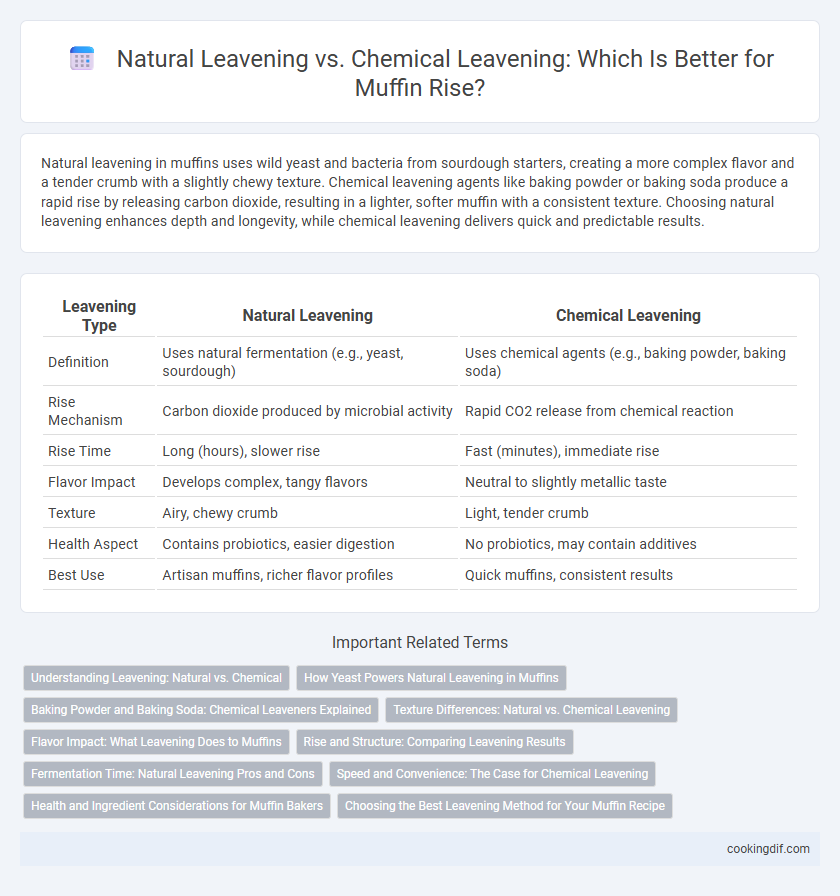Natural leavening in muffins uses wild yeast and bacteria from sourdough starters, creating a more complex flavor and a tender crumb with a slightly chewy texture. Chemical leavening agents like baking powder or baking soda produce a rapid rise by releasing carbon dioxide, resulting in a lighter, softer muffin with a consistent texture. Choosing natural leavening enhances depth and longevity, while chemical leavening delivers quick and predictable results.
Table of Comparison
| Leavening Type | Natural Leavening | Chemical Leavening |
|---|---|---|
| Definition | Uses natural fermentation (e.g., yeast, sourdough) | Uses chemical agents (e.g., baking powder, baking soda) |
| Rise Mechanism | Carbon dioxide produced by microbial activity | Rapid CO2 release from chemical reaction |
| Rise Time | Long (hours), slower rise | Fast (minutes), immediate rise |
| Flavor Impact | Develops complex, tangy flavors | Neutral to slightly metallic taste |
| Texture | Airy, chewy crumb | Light, tender crumb |
| Health Aspect | Contains probiotics, easier digestion | No probiotics, may contain additives |
| Best Use | Artisan muffins, richer flavor profiles | Quick muffins, consistent results |
Understanding Leavening: Natural vs. Chemical
Natural leavening, commonly using ingredients like sourdough or yeast, relies on fermentation processes to produce carbon dioxide, creating a light and airy muffin texture with complex flavors. Chemical leavening agents such as baking powder and baking soda release carbon dioxide rapidly through acid-base reactions, resulting in quick rise but often a less nuanced taste. Choosing between natural and chemical leavening impacts muffin moisture, crumb structure, and flavor depth, with natural methods favoring longer proofing times and chemical leavening offering convenience and consistency.
How Yeast Powers Natural Leavening in Muffins
Yeast powers natural leavening in muffins by feeding on sugars and releasing carbon dioxide, which creates air pockets and results in a light, airy texture. Unlike chemical leavening agents like baking powder or baking soda, yeast fermentation develops complex flavors and improves crumb structure. This biological process requires time but enhances muffin rise through gradual gas expansion and gluten development.
Baking Powder and Baking Soda: Chemical Leaveners Explained
Baking powder and baking soda are common chemical leaveners that release carbon dioxide gas to create the rise in muffins by reacting with moisture and heat. Baking soda requires an acid like buttermilk or yogurt to activate, producing a faster rise, while baking powder contains both the acid and base components, providing a more controlled, consistent leavening effect. Understanding the difference between these two helps bakers achieve the desired texture and volume in muffins without relying on natural leavening agents like yeast or sourdough.
Texture Differences: Natural vs. Chemical Leavening
Natural leavening, using sourdough or wild yeast, produces a muffin texture that is moist, tender, and slightly chewy with complex, tangy flavors. Chemical leavening agents like baking powder or baking soda create a lighter, fluffier crumb, often with a finer, more uniform structure but less depth in taste. The choice between natural and chemical leavening significantly influences the muffin's texture, moisture retention, and overall mouthfeel.
Flavor Impact: What Leavening Does to Muffins
Natural leavening agents like sourdough starter impart complex, tangy flavors to muffins, enhancing depth and aroma through fermentation. Chemical leaveners such as baking powder and baking soda produce a neutral rise, allowing other ingredients' flavors to shine without altering the muffin's taste profile. The choice between natural and chemical leavening significantly influences the muffin's flavor complexity and overall sensory experience.
Rise and Structure: Comparing Leavening Results
Natural leavening, using yeast or sourdough, produces a slower rise that enhances flavor complexity and creates an open, airy crumb structure in muffins. Chemical leavening agents like baking powder and baking soda react quickly, generating carbon dioxide that provides an immediate lift and a tender, uniform crumb. The choice between natural and chemical leavening impacts muffin rise height, texture, and overall mouthfeel, with natural methods favoring depth and chew, while chemical agents ensure consistent volume and softness.
Fermentation Time: Natural Leavening Pros and Cons
Natural leavening relies on fermentation time where wild yeast and bacteria metabolize sugars, producing carbon dioxide that gently elevates muffin batter for a tender crumb and complex flavor profile. Extended fermentation enhances micronutrient bioavailability and digestibility but requires precise temperature control and patience to avoid overproofing and sourness. In contrast, chemical leavening agents provide rapid rise without fermentation, sacrificing nuanced taste and health benefits inherent in natural leavening.
Speed and Convenience: The Case for Chemical Leavening
Chemical leavening agents such as baking powder and baking soda provide rapid rise in muffin batter by producing carbon dioxide almost immediately upon mixing, ensuring faster baking times compared to natural leavening methods like sourdough starter. This accelerated reaction enhances convenience, making chemical leavening ideal for quick muffin preparation and consistent results. The speed advantage allows bakers to produce muffins efficiently without the extended fermentation and proofing periods required by natural leavening, supporting high demand and streamlined workflows.
Health and Ingredient Considerations for Muffin Bakers
Natural leavening agents, such as sourdough starter, promote better digestion and contain beneficial probiotics, making muffins healthier compared to those made with chemical leavening agents like baking powder. Chemical leaveners often include additives and aluminum compounds that may cause digestive discomfort or allergic reactions in sensitive individuals. Muffin bakers focusing on health-conscious recipes prefer natural leavening for cleaner ingredient profiles and improved nutrient absorption.
Choosing the Best Leavening Method for Your Muffin Recipe
Natural leavening methods like sourdough starters create muffins with a complex flavor profile and a tender crumb due to slow fermentation, while chemical leavening agents such as baking powder and baking soda ensure a quick and consistent rise. Selecting the best leavening depends on the desired texture and taste; natural leavening offers depth and chewiness, whereas chemical leavening yields light, fluffy muffins in less time. For home baking, chemical leavening is often preferred for convenience and predictability, whereas natural leavening appeals to artisanal bakers seeking nuanced flavor development.
Natural leavening vs Chemical leavening for rise Infographic

 cookingdif.com
cookingdif.com